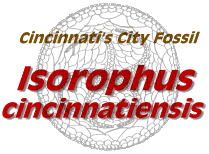

Edrioasteroids are extinct members of the phylum Echinodermata that today includes such marine organisms as starfish and sea urchins. Like all echinoderms, the skeleton of an edrioasteroid is composed of a large number of elements called "plates."
Edrioasteroids are relatively uncommon fossils in the local Cincinnatian strata, but when discovered, they generally are found in fairly large numbers.
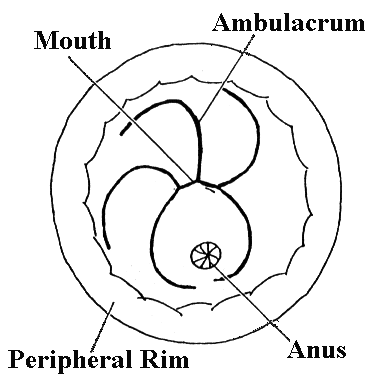
Edrioasteroids have a relatively simple body plan that is composed of a "theca," or main body, made up of scale-like plates. The theca is always attached by a ring called the "peripheral rim" to a hard object like a brachiopod shell or hardened sea floor. On the surface of the theca are five arms called "ambulacra" that radiate from a central mouth. The anus is typically a large code made of small triangular plates. Differences in the ambulacral curvature and the plating covering the ambulacra and the mouth form the basis for telling apart species of edrioasteroids.
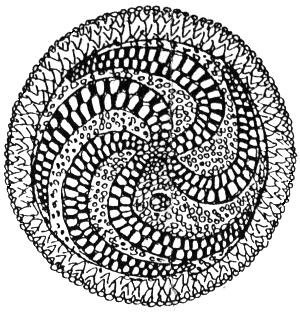
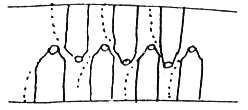
Typically, Streptaster vorticellatus is a small and rare
edrioasteroid with prominent ambulacra that all curve counterclockwise. The
theca is covered by small plates with small bumps and the widely spaced cover
plates are tall with small spines at the tip.
Click here for a large photo of Streptaster
(file size 103k).
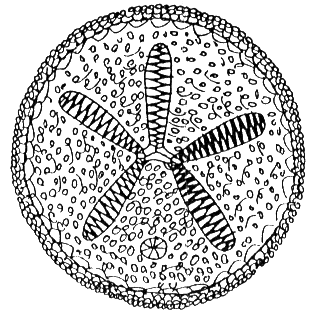
Cystaster is a small edrioasteroid characterized by high, straight
ambulacra that are very wide. The theca can be circular to nearly pentagonal. Cystaster
is represented in the Cincinnatian by two species that are very difficult to
tell apart.
Click here for a large photo of Cystaster.
(file size 94k)
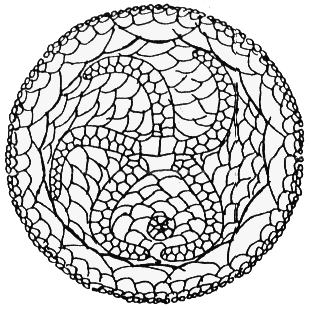
Carneyella is characterized by wide ambulacra, four of which curve in a counter clockwise direction and the fifth, clockwise. The ambulacra have a single set of alternating cover plates. The mouth is covered by three very large plates, and the three species found locally can be distinguished from each other by the number of bumps on the cover plates.

Carneyella pilea is the common species of Carneyella and is the second most common of Cincinnati's edrioasteroids. It has smooth thecal plates and smooth cover plates with no small bumps.

Carneyella faberi looks almost exactly like Carneyella pilea except that the surface is covered with small bumps and there are two bumps on each cover plate.

Carneyella ulrichi looks like Carneyella pilea except that the
theca is covered with large bumps and there is one bump on each cover plate.
Click here for a large photo of Carneyella.
(file size 196k)
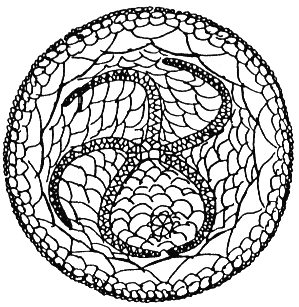
Isorophus cincinnatiensis is the most common of Cincinnati's edrioasteroids. Four of its slender ambulacra curve counterclockwise and one curves clockwise, The easiest way to distinguish Isorophus and Carneyella is to look at the mouth and ambulacra. Isorophus has four small plates over the mouth and thin ambulacra whereas Carneyella has three large plates over the mouth and wide ambulacra.

Isorophus cincinnatiensis has two sets of cover plates - large ones
marked "1" in the drawing above, and small ones marked "2."
This characteristic separates Isorophus from all other Cincinnatian
edrioasteroids.
Click here for a large photo of Isorophus.
(file size 158k)
Isorophus cincinnatiensis was named Cincinnati's official city fossil.

Curvitriordo looks like Isorophus except that there is a third set of cover plates on the ambulacra, marked "3" in the drawing above. There are several species found locally, and may be more common than previously recognized.
![]()
Related Topics
![]()
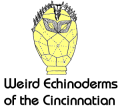
Click here to see photos of
Edrioasteriods
See Photos of Edrios Found on Field Trips
How to Dig Edrios
Some Cincinnati Crinoids
Back to Dry Dredgers Home Page
The Dry Dredgers and individual contributors reserve the
rights to all information, images, and content presented here. Permission to
reproduce in any fashion, must be requested in writing to admin@drydredgers.org.
www.drydredgers.org is designed and maintained by Bill
Heimbrock.